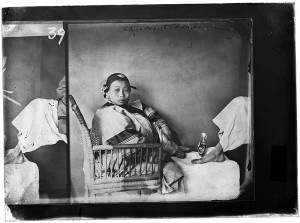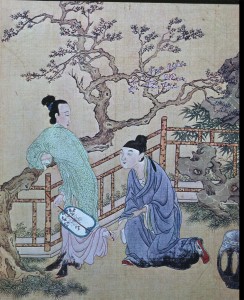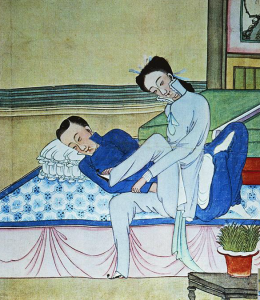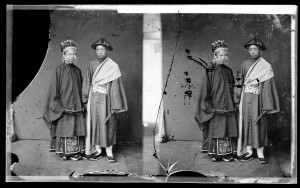
Source: Thomson, John: “Canton, Bride, and Bridegroom”, 1869
The photo I have selected, “Canton, Bride, and Bridegroom” illustrates the strong role concealment played in creating an allure for footbinding. In her piece “The Body as Attire: The Shifting Meanings of Footbinding in Seventeenth- Century China”, Dorothy Ko asserts the appeal and alluring nature of footbinding, stating “To be provocative, a pair of small feet had to be covered by binder, socks, and shoes dredged with perfume and fragrant powder, then hidden under leggings and skirts.” (Ko, P. 16) Although Ko is assessing the portrayal and message of footbinding in the seventeenth century, after viewing Thomson’s work, it becomes clear that this notion of draping the body with skirts and embellishing it with ornaments has held strong for a very long time. Featured are a bride and groom on their wedding night in late 19th century China. At first glance, the couple shown seems to be completely plain and emotionless in face, attesting to the idea that beauty in China is not at all dependent on facial appearance; however, beauty was more focused on the adornment and embellishment of body, specifically with emphasis on the bound feet.
The bride’s stature and dress, as well as her body positioning in relation to her husband serve as symbols to further evidence the idea that the beauty in footbinding lie in the adornment and covering up of the body. From head to toe, the bride is completely covered- her legs are draped over with a long skirt only faintly showing the tips of her slippers, making them seem even more mysterious and exotic in nature. Her long, plain vest furthers this concealment, robbing her body of any shape or femininity, bringing more attention to the delicate nature of her feet. Her expressionless face is covered in jewelry, not only serving the purpose of taking attention away from her face, but also serving as an indicator of higher class in Chinese society. Then, we can observe the positioning of her husband in relation to her body. The first obvious comparison to make is his large feet in relation to her delicate bound feet, perhaps done on purpose to create a greater allure for the bride. Then, we can observe the distance between them: although they have just married, they stand as though they are strangers, adding an air of mystery to the photo, a quality very commonly associated with footbinding. All of the components of Thomson’s photo come together to communicate a portrayal of footbinding that finds its power and intrigue in the art of concealment.
Yes, the art of concealment and explain connotation of “the concealment.”
-Allie Williams

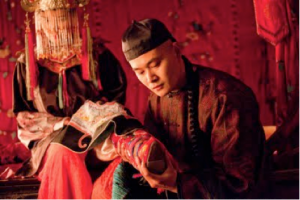 rnate headdress, and the man in the foreground dressed in traditional Chinese apparel examining her feet. The woman’s face is shielded so it is difficult to understand her facial expression, but the man looks very inquisitive. Connotatively, one might assume only the woman’s face is covered because women were seen as more submissive than men, and during this time covering everything was the norm for women. The man seems to not only be looking at her feet, but also judging them and seems appealed that this woman went through the foot binding process. Her face is less important than the fact that her feet are bound and that she is properly expressing the female image. stay with the statement of “the boundfeet as man’s sexual desiring object.”
rnate headdress, and the man in the foreground dressed in traditional Chinese apparel examining her feet. The woman’s face is shielded so it is difficult to understand her facial expression, but the man looks very inquisitive. Connotatively, one might assume only the woman’s face is covered because women were seen as more submissive than men, and during this time covering everything was the norm for women. The man seems to not only be looking at her feet, but also judging them and seems appealed that this woman went through the foot binding process. Her face is less important than the fact that her feet are bound and that she is properly expressing the female image. stay with the statement of “the boundfeet as man’s sexual desiring object.”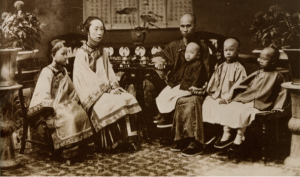 o symbolize the female image of Chinese culture. The men are looking at the camera, they appear more relaxed while the women’s feet are bound, and they are sitting very submissively making a conscious effort to not look towards the camera.
o symbolize the female image of Chinese culture. The men are looking at the camera, they appear more relaxed while the women’s feet are bound, and they are sitting very submissively making a conscious effort to not look towards the camera.